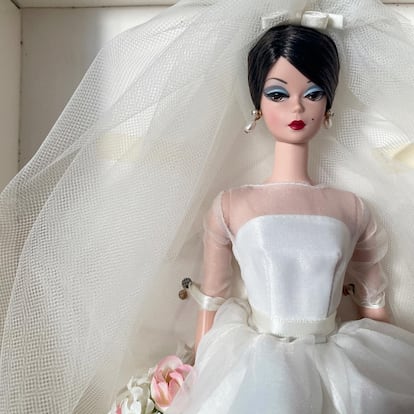Meet the huge community of Barbie collectors: ‘When people find out, they look at you like you’re from Mars’
The pandemic motivated many devoted fans of the most famous doll in the world to dust off their beloved treasures and show them off online

In the book Forever Barbie: The Unauthorized Biography of a Real Doll, author M.G. Lord refers to Barbie as the ultimate piece of popular art; one that was created to be consumed by everybody, not just a few. Today a Barbie doll is sold every three seconds – and, like all works of art, they are also collected and exhibited. The collectors are Instagrammers, and their accounts are akin to a gallery one would visit on a Sunday morning after enjoying an overpriced brunch.
Mattel is aware that a fundamental part of Barbie’s legacy is in the hands of the collectors, and the company acknowledges the value they give to the brand. Each Instagram collector offers a unique, distinctive identity, along with a personal story of how they came to feel understood and protected among their followers and their likes.

@barbie_lover_spain was three years old the first time a Barbie doll fell into his hands. It was a very disheveled 1989 Dance Magic Barbie that belonged to his older cousin. “For me [Barbie] became a great refuge, because sometimes I felt a little alone,” he admits. @barbie_coleccionista used to watch his sister play without being able to participate, while @barbiecollectorpy did play, but secretly. All @condecollector wanted to get for the holidays, every year, was a Barbie doll. @archivobarbie said he was the “sissy” who played with dolls in the schoolyard, and @barbielovercolombia dreamed of being a girl – specifically, her.
The Covid-19 pandemic prompted many collectors to dust off their treasures and show them off online. During that time, many accounts opened the doors of their collections. “It was a way to connect with people who were using the same resource to escape reality,” recalls @barbie_lover_spain. Between tricks, tips and sales, the different types of collectors took shape. There is the “in box collector,” who only buys dolls that have never been taken out of their original packaging; the “out of box collector,” who doesn’t mind purchasing dolls that have been outside; and the “rescue collector,” who enjoys restoring somewhat battered dolls.
The collections can be focused on characters and accessories: Barbie, Ken, Barbie’s family and friends, playsets and clothing sets; on the head molds, whose faces have been changing over time; on dolls that capture the spirit of an era, such as the Superstar era of the 1970s or the Generation Girl era from the early 2000s; on Barbie Playline, the ones that can be found in any toy store, or Collector Dolls, with a more detailed, delicate design; or on international productions from the time when Mattel granted manufacturing and distribution licenses to countries like Spain, Mexico, Venezuela or Peru, and which can fetch the highest prices in the “rare” category.

Some have professionalized their hobby by associating their personal image with the doll. “Being part of the community helped me overcome my shyness when making videos for my YouTube channel or speaking publicly about Barbie,” says @barbielovercolombia. “The community gives me and my country that visibility [...] Now, in live streams or in events, they always invite ‘the guy from Paraguay.’ It’s a real honor,” says @barbiecollectorpy. Then there are those who do not show their faces. “It’s something that I don’t talk about much; the truth is that I’ve done it pretty much alone. I just thought that someone might be interested in my collection,” admits @archivobarbie.
The common denominator that motivates the collectors, the base that sustains this new online community, is nostalgia. Emily Aguiló-Pérez, who devotes part of her career to studying the Barbie phenomenon in childhood, confirms this: “In the collectors who participated in my study, I recognized a sense of nostalgia [...] For instance, one of them never had a Barbie when she was little, and just displaying her collection in her living room gave her joy.” Mattel agrees: “There is no doubt that our products cause great nostalgia.” They know it and reinvent their market by creating items that produce that feeling, identifying and feeding the trends followed by kidults with specific lines of collectibles: “We are aware of the phenomenon [...] Iconic brands like Barbie, due to their weight and history, have always been a benchmark among the collector niche.”
This is where the first trace of an apparent controversy sneaks in: adults collecting dolls. “When people find out that you are an adult who collects Barbie dolls, they look at you like you´re from Mars,” says @barbie_lover_spain, “you realize that there are guys who make models of planes, cars, ships, and no one finds it strange, but as an adult who collects dolls, you’re a freak,” he concludes. Aguiló-Pérez points to another aspect that goes beyond the doll as an object: “Barbie is a figure of opulence: she has the car and the mansion, but tries to convey a social message [...], she wants to reach a broader population, but things continue to revolve around a white, blue-eyed Barbie,” she says, noting that while this is not necessarily a contradiction, it is a complexity.
In the words of Lord, for every collector for whom Barbie represents an exquisite language, there is a writer or a visual artist for whom the doll is both muse and metaphor, and whose message has to do with social injustice. “You have to have a balance. In real life I surely wouldn’t have a friend like Barbie; she wouldn’t be interested me, nor I in her. It is a character to play with, it is the fascination for the grotesque, the baroque, the circus, the fantasy,” says @archivobarbie. Among collectors, there is an appreciation for the aspirations that the doll represents, as well as the therapeutic nature of the act of collecting. “Beyond the plastic, to me she is synonymous with fulfilling dreams,” says @barbiecollectorpy. “Barbie is closely linked to my work […] I always wanted to work in the world of fashion, and she represented it,” says @condecollector. “I was constantly making them dresses with napkins [...] Since I was little I wanted to do something related to clothes [...], it helped me get into the world of fashion as an adult and develop a greater sensitivity,” admits @barbie_lover_spain. “It is a distraction when I’m overwhelmed; just seeing them all together gives me satisfaction. It’s cool,” says @barbie_coleccionista.
Lord likens the disparate and controversial idea of Barbie to a Rorschach test: each person projects diametrically opposed illusions from an apparently universal image, but in the end, each representation is considered valid and, above all, purely personal. That is why, at least on Instagram, collectors have a platform where the focus on Barbie is shared, legitimate, collective, and yes –fabulous, too.
The best collections






Some interesting facts about Barbie
In 1977, Mattel gave Spain a license to produce Barbie dolls in the factories of the Congost company. Before that, Barbie had been banned in the country due to the Franco dictatorship. The molds belonged to Mattel, but the details of the face, hair and makeup were different from those of the American prototype. Special editions such as the 10th Anniversary Barbie from 1987 and the Top Model Barbie from 1989 that can now be found on Ebay for approximately $960 were created there.
Mexico is the only country that gave Barbie an international friend: Valerie, created by the Cipsa company. It was only available there during the 1970s.
The Totally Hair Barbie is the best-selling Barbie doll to date. It had a 1990s style and the longest hair of all: 8.5 inches.
In 2019, Barbie received the Board of Directors Tribute Award from the Council of Fashion Designers of America for her influence on the fashion industry. Bob Mackie, Bill Blass, Vera Wang, Carolina Herrera and Pertegaz are some of the designers that we could find if we take a peek in her closet.
-There was a controversial version of Skipper Roberts, Barbie’s little sister, released in 1975. When her arm was rotated, breasts would grow on the chest of Growing Up Skipper, simulating the arrival of puberty. It was withdrawn from the market and Skipper remained a teenager forever.
-In the 1970s, Mattel also granted production licenses to different Latin American countries. This is how the models known as “rare Barbie dolls,” due to the peculiarities of each country’s adaptations, came to the collector market. One can still find Barbie dolls produced in Colombia (Dibon Barbie), Mexico (Cipsa Barbie) or Peru (Basa Barbie); currently, their prices can reach almost $5,000, as is the case of Miss Barbie Reina de Belleza from Rotoplast, in Venezuela.
Sign up for our weekly newsletter to get more English-language news coverage from EL PAÍS USA Edition
Tu suscripción se está usando en otro dispositivo
¿Quieres añadir otro usuario a tu suscripción?
Si continúas leyendo en este dispositivo, no se podrá leer en el otro.
FlechaTu suscripción se está usando en otro dispositivo y solo puedes acceder a EL PAÍS desde un dispositivo a la vez.
Si quieres compartir tu cuenta, cambia tu suscripción a la modalidad Premium, así podrás añadir otro usuario. Cada uno accederá con su propia cuenta de email, lo que os permitirá personalizar vuestra experiencia en EL PAÍS.
¿Tienes una suscripción de empresa? Accede aquí para contratar más cuentas.
En el caso de no saber quién está usando tu cuenta, te recomendamos cambiar tu contraseña aquí.
Si decides continuar compartiendo tu cuenta, este mensaje se mostrará en tu dispositivo y en el de la otra persona que está usando tu cuenta de forma indefinida, afectando a tu experiencia de lectura. Puedes consultar aquí los términos y condiciones de la suscripción digital.
More information
Archived In
Últimas noticias
Imelda Castro, the woman who wants to rule the cartel battleground of Sinaloa
The new victims of the Republican war on Obamacare: Millions hit by soaring health insurance premiums
A country divided on migrant rights: Some US states expand protections while others restrict them
Venezuela authorizes the release of another 87 political prisoners
Most viewed
- David King, chemist: ‘There are scientists studying how to cool the planet; nobody should stop these experiments from happening’
- Reinhard Genzel, Nobel laureate in physics: ‘One-minute videos will never give you the truth’
- Oona Chaplin: ‘I told James Cameron that I was living in a treehouse and starting a permaculture project with a friend’
- Sinaloa Cartel war is taking its toll on Los Chapitos
- World economy in 2026: Three scenarios and a dystopia










































